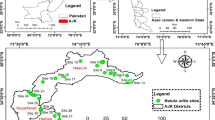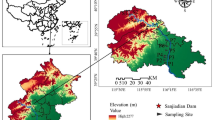Abstract
The features of the restorative successions in landscapes with different degree of anthropogenic disturbance are considered (southeastern Belarus). The comparative analysis for succession characteristics of weakly and strongly disturbed landscapes is conducted. It is established that restorative succession in a strongly disturbed landscape is characterized by a lower plant succession rate, significant delay at the nonforest stages (including pioneering stage), high degree of synanthropization, and significant level of plant adventization at all stages.
Similar content being viewed by others
References
Landshafty Belorussii (Landscapes of Belorussia) Martsinkevich, G.I, Klitsunova, N.K, Ed., Minsk: Universitetskoe, 1989.
Mirkin, B.M., Naumova, L.G., and Solomeshch, A.I., Sovremennaya nauka o rastitel’nosti (Actual Vegetation Science), Moscow: Logos, 2002.
Braun-Blanquet, J., Pflanzensociologie. Wien; New York: Springer-Verlag, 1964, p. 865.
Matuszkiewiecz, W., Przewodnik do oznaszania zbiorowisk rylblinnych Polski. Warszawa: PWN, 1984, p. 298.
Bulokhov, A.D. and Solomeshch, A.I., Ekologo-floristicheskaya klassifikatsiya lesov Yuzhnogo Nechernozem’ya Rossii (Ecological and Floristical Classification of Southern Non-Chernozemic Belt of Russia), Bryansk: Izd-vo BGU, 2003.
Diagnozy i klyuchi vozrastnykh sostoyanii lesnykh rastenii: derev’ya i kustarniki. Metodicheskie razrabotki (The Diagnosises and Keys of Age Stages of Forest Plants: Trees and Shrubs. Methodical Developments), Moscow: Prometei, 1989, p. 104.
Smirnova, O.V., Bobrovskii, M.V., and Khanina, L.G., Ispol’zovanie demograficheskikh metodov dlya otsenki i prognoza suktsessionnykh protsessov v lesnykh tsenozakh (The Use of Demographic Methods for Evaluation and Prognoses of Successional processes in Forest Cenosises), Byul. MOIP, Ser. Biol., 2001, vol. 106, no. 5, pp. 26–34.
Smirnova, O.V., Metodologicheskie podkhody i metody otsenki klimaksovogo i suktsessionnogo sostoyaniya lesnykh ekosistem (na primere vostochnoevropeiskikh lesov), Lesovedenie, (The Methodologic Approaches and Methods of Evaluation of Climax and Successional Stage of Forest Ecosystems (on an Example of Eastern Europe Forests) Forest Science, 2004, no. 3, pp. 15–27.
Volkov, S.N., Zemleustroistvo v usloviyakh zemel’noi reformy (ekonomika, ekologiya, pravo) (Land Organization in Conditions of Land Reform (Economy, Ecology, Law)), Moscow: Bylina, 1998.
Agroekologiya (Agroecology) Chernikov, V.A, Chekeres, A.I, Ed., Moscow: Kolos, 2000.
Author information
Authors and Affiliations
Corresponding author
Additional information
Original Russian Text © A.P. Gusev, 2012, published in Sibirskii Ekologicheskii Zhurnal, 2012, No. 2, pp. 231–236.
Rights and permissions
About this article
Cite this article
Gusev, A.P. Features of plant succession in landscapes disturbed by anthropogenic activity (by example of southeastern Belarus). Contemp. Probl. Ecol. 5, 174–178 (2012). https://doi.org/10.1134/S1995425512020060
Published:
Issue Date:
DOI: https://doi.org/10.1134/S1995425512020060




